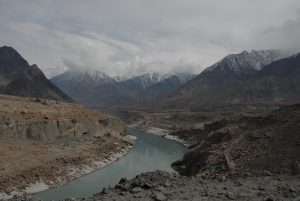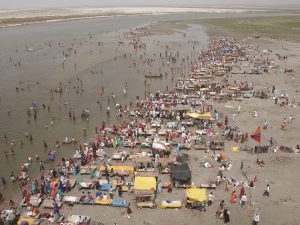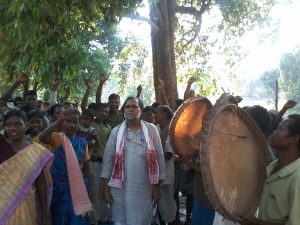From March 31 to April 4 what was dubbed as “the biggest river festival” in India took place across 21 districts of Assam. Inaugurating the Namami Brahmaputra (obeisance to the Brahmaputra) festival, the President of India Pranab Mukherjee called rivers the “carriers of civilisation” while highlighting the “immense development potential” of Assam. The President added that the Brahmaputra, which is the lifeline of Assam and the region, is intertwined into the economy, culture and day-to-day life of the people of the areas through which it flows. “The North East’s culture, economy and essential ingredients flourished on the bank of mighty Brahmaputra,” the President said, and expressed his hope that such festivals would boost tourism and economic activity.
During his speech, Mukherjee emphasised that an inland water transport system as envisaged in the National Waterways Act could be the catalyst in changing the economic scenario of the region. The development of the Brahmaputra into a national waterway could give Assam access to international ports like Chittagong in Bangladesh. This would give Assam an exposure to international trade and commerce. The state is perfectly positioned to become India’s link to the ASEAN nations as the ‘Act East’ policy of the Indian government is brought to the forefront.
Reviving the Brahmaputra
However, former chief minister of Assam Tarun Gogoi was fairly critical of the festival, and said, “Namami Ganga Festival was celebrated to accelerate the cleaning of the sewage and industrial wastes from the Ganga river so that people could benefit from it but here, Namami [Brahmaputra] Festival is organised just for the sake of merry making. Brahmaputra affects the whole economy of Assam. Every year hundreds of people die, thousands are rendered homeless, landless due to the havoc called flood wreaked by the Brahmaputra. Around 8,000 hectares of land are already lost. We do not want a festival but a rejuvenation of Brahmaputra to benefit the state’s economy. People need benefit in navigation as well as in river transportation.”
In an apparent response to such criticisms, a tripartite agreement for dredging the Brahmaputra was signed between the Assam government, the Inland Waterways Authority of India and the National Highway Authority of India in presence of Union Minister of Road Transport and Highways and Shipping Nitin Gadkari at the closing ceremony of the Namami Brahmaputra Festival on April 4. Gadkari said that the project would change the entire economic scenario of Assam. The Brahmaputra National Waterway 2 would act as the economic corridor that would have direct access to Chittagong Port in Bangladesh and the Haldia Port in West Bengal and boost trade with Southeast Asian countries.
The central government has assured Assam full cooperation in this ambitious project and the union minister also announced that the centre would release INR 400 billion (USD 6.2 billion) for the construction of the ambitious Brahmaputra Express Highways on both banks of the river, each 840 km long, from Sadiya to Dhubri. A preliminary survey has been completed. “As per laid down norms, survey on the Brahmaputra river, which has been declared as National Waterway No 2, needs to be conducted every four years, but no survey was earlier carried out,” sources from the Water Resource Department revealed and said that the dredging of Brahmaputra will be carried out with the help of Dredging Corporation of India (DCI) to deal with annual flooding and erosion problem in the river.
An expert team from DCI had visited Assam in September 2016 and had submitted a preliminary report stating that a detailed morphological and hydrological study of the river is required to explore the possibilities for dredging its huge sediment deposits. According to the chief minister of Assam, Sarbananda Sonowal, dredging 1,300 kilometres of the Brahmaputra would also provide material needed to build the highway, making it a win-win solution.
The Brahmaputra basin
The Brahmaputra is the lifeline for communities living along its banks and nourishes the fragile ecology of the eastern Himalayan region. With a total drainage area of 573,394 square kilometres, the northeast of India, drained by the Brahmaputra river system, possesses about 30% of the total water resources potential of the country. The per capita and per hectare availability of water in this region is the highest in India.

Challenges in navigation
The Brahmaputra lacks basic navigational aids like channel marks for day navigation as well as night navigation aids, although there is an effort to fix this. More importantly the Brahmaputra’s flows are declining, and this is not something that a quick fix of the infrastructure is going to be able to deal with.
The flow of the Brahmaputra is said to have declined by some 4% in the past four decades. The rise in temperature due to climate change tends to change the snow and glacier covers of the Himalayas and subsequently change the flow scenarios of the river. Several studies conducted in India and abroad opined that climate change may have significant impact on the flow of the Brahmaputra. The monsoon flow of the river may increase while the lean period flow may decrease.
A European Commission-sponsored project earlier showed the Brahmaputra discharge at risk of 15% to 25% reduction by the end of this century. The project that studied the monsoon discharge and base flow of the river concluded that while most of the monsoon discharge of the river is generated from the precipitation taking place in the north-eastern Indian basin of the river, the base flow of the river is dependent on the glacial melt at the source, in Tibet. While retreating glaciers have added to the flow in the recent past, over time as the glaciers recede, the flow from glacial melt will also decrease.
It may take more than a festival, or a bonanza of infrastructure projects, to protect the Brahmaputra, and make it, once again, the cultural and economic lifeline of all the people living in the basin.
![<p>A ferry in Guwahati – basic transport that could be so much more [image by Chandan Kumar Duarah]</p>](https://dialogue.earth/content/uploads/2017/04/IWT-ferry-in-Guwahati-city-Chandan-Kumar-Duarah.jpg)







